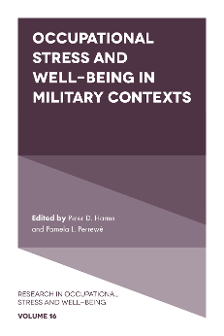
Index
Occupational Stress and Well-Being in Military Contexts
ISBN: 978-1-78756-184-7, eISBN: 978-1-78756-183-0
ISSN: 1479-3555
Publication date: 5 September 2018
Citation
(2018), "Index", Harms, P.D. and Perrewé, P.L. (Ed.) Occupational Stress and Well-Being in Military Contexts (Research in Occupational Stress and Well Being, Vol. 16), Emerald Publishing Limited, Leeds, pp. 187-193. https://doi.org/10.1108/S1479-355520180000016013
Publisher
:Emerald Publishing Limited
Copyright © 2018 Emerald Publishing Limited
INDEX
- Prelims
- Processing War: Similarities and Differences in PTSD Antecedents and Outcomes between Military and Civilian War Survivors
- Cold-blooded Killers? Rethinking Psychopathy in the Military
- Measuring Job Performance in the Army: Insights from Evidence on Civilian Stress and Health
- Work, Stress, and Health of Military Couples across Transitions
- Fighting for Family: Considerations of Work–Family Conflict in Military Service Member Parents
- Examining Veteran Transition to the Workplace through Military Transition Theory
- Psychosocial Health Prevention Programs in Military Organizations: A Quantitative Review of the Evaluative Rigor Evidence
- Pain in the Civilian and Military Workplace
- Index